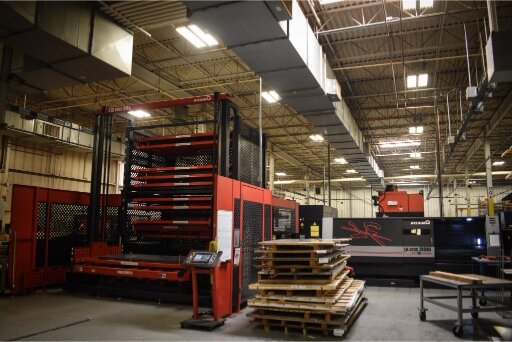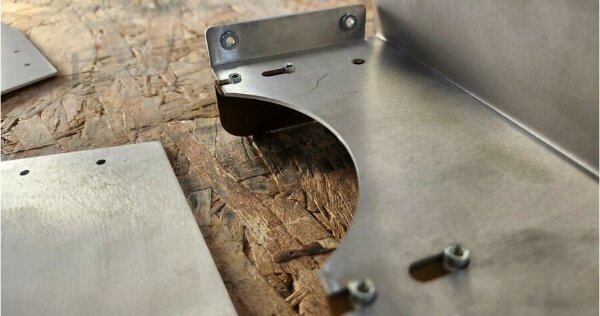Quando si lavora il metallo, la scelta di un metodo di fabbricazione esemplare è fondamentale. Questa decisione può avere un impatto su tutto, dai tempi di produzione ai costi, alla durata e alle prestazioni. Sia che si tratti di costruire prototipi o di prepararsi per una produzione su larga scala, la scelta del metodo corretto può aiutare a semplificare il progetto e a garantirne il successo. Ma con così tante opzioni, qual è la migliore per le vostre esigenze?
La comprensione delle esigenze specifiche del progetto è la chiave per scegliere il metodo di fabbricazione corretto. Con il giusto approccio, è possibile ottimizzare sia i costi che l'efficienza, sia che si tratti di creare piccoli componenti o grandi assiemi.

Che cos'è la lavorazione dei metalli?
La fabbricazione dei metalli è un processo di creazione di strutture e parti da vari materiali metallici. Comporta il taglio, la piegatura, la sagomatura e l'assemblaggio di metalli per formare prodotti personalizzati. Si tratta di varie tecniche utilizzate per realizzare qualsiasi cosa, dai telai delle automobili agli involucri elettronici.
Contribuisce alla creazione di prototipi personalizzati e di pezzi in grandi volumi. La fabbricazione consente ai produttori di ottenere precisione, coerenza e risparmio sui costi in progetti diversi.
Tipi di processi di fabbricazione dei metalli
La fabbricazione dei metalli comprende vari processi, ognuno dei quali ha uno scopo specifico. Questi processi aiutano a creare pezzi con la forma, la resistenza e le dimensioni adatte a diverse applicazioni.
Taglio
Il taglio è uno dei metodi più comuni nella fabbricazione dei metalli. Consiste nel dividere un pezzo di metallo in sezioni più piccole. I metodi tradizionali, come la segatura, sono ancora oggi utilizzati. Tuttavia, le tecniche moderne come le forbici elettriche, getto d'acqua, laser, E Taglio al plasma offrono una maggiore precisione. Questi metodi sono efficaci per modellare il metallo o prepararlo per ulteriori lavorazioni.
Il taglio può essere eseguito in vari modi, utilizzando frese elettriche, manuali o CNC. A seconda delle esigenze, può essere la prima o l'ultima fase del processo. Un altro metodo di taglio molto diffuso è la fustellatura, che prevede l'utilizzo di strumenti a spigoli vivi per tagliare il metallo.
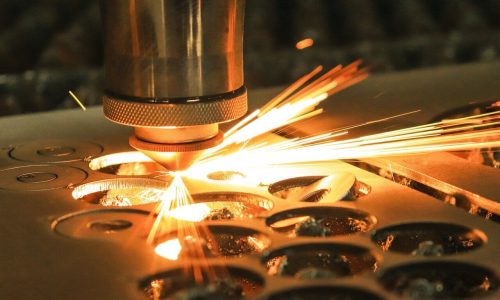
Piegatura
Piegatura è utilizzato per creare forme curve nel metallo. È una parte fondamentale di fabbricazione di lamiere. Macchine come le presse piegatrici applicano una forza per piegare il metallo nella forma giusta. Il metodo di piegatura dipende da fattori quali lo spessore, la forma e l'angolo del materiale.
Questo processo è essenziale per realizzare parentesi, scatolee condotti. Può essere utilizzata anche per creare disegni più complessi. La sfida della piegatura consiste nell'evitare di incrinare o deformare il materiale durante il processo.
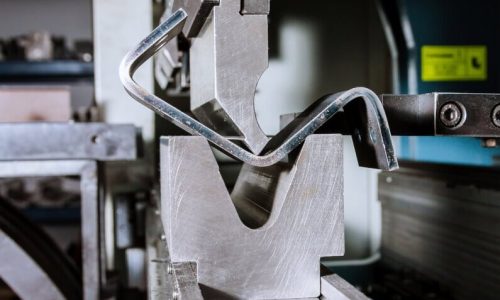
Saldatura
Saldatura consiste nell'unire pezzi di metallo fondendoli e aggiungendo un materiale d'apporto, creando un forte legame tra di essi. Esistono diversi tipi di saldatura, come Saldatura MIG (Metal Inert Gas), Saldatura TIG (Tungsten Inert Gas)., E saldatura a bastone. Ogni tipo è adatto a materiali e usi diversi.
La saldatura è comunemente utilizzata per realizzare componenti e strutture per impieghi gravosi. È fondamentale in settori come quello edile, automobilistico e aerospaziale. La qualità della saldatura è fondamentale per garantire la resistenza e la durata del prodotto finale.

Timbratura
Timbratura è un processo in cui una lamiera viene pressata in uno stampo per formare una forma. È eccellente per la produzione di grandi volumi perché può creare forme complesse in modo rapido e preciso. Lo stampo è progettato con bordi affilati per garantire tagli netti.
La tranciatura è spesso utilizzata nell'industria automobilistica ed elettronica per realizzare parti come staffe, coperture e pannelli. È un metodo efficiente ed economico per la produzione su larga scala.
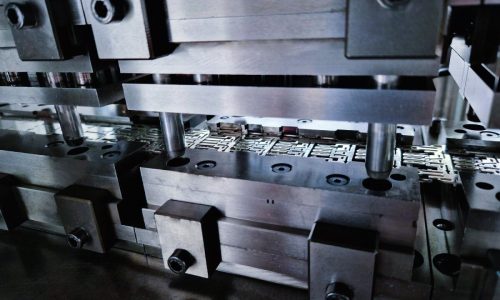
Lavorazione
La lavorazione consiste nel rimuovere materiale da un pezzo per modellarlo o rifinirlo. Strumenti come esercitazioni, torni e Macchine CNC vengono utilizzati per il taglio, macinareo lucidare il metallo. La lavorazione è ideale per produrre pezzi precisi con tolleranze ristrette.
Viene spesso utilizzato per realizzare componenti dettagliati e intricati. Il processo funziona bene con molti materiali, come metalli, plastiche e materiali compositi. Il suo principale vantaggio è la capacità di creare pezzi complessi e precisi.
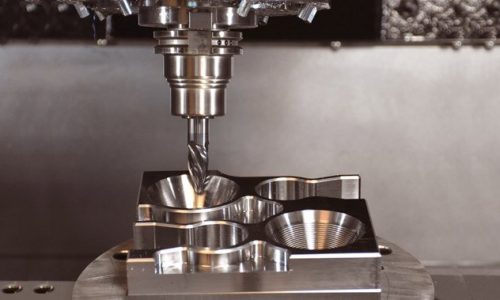
Estrusione
Estrusione è un metodo in cui un materiale, di solito metallo, viene forzato attraverso uno stampo per creare una forma continua con una sezione trasversale fissa. Il materiale viene riscaldato prima di essere spinto attraverso lo stampo, dando forma al prodotto finale.
Questo processo consente di realizzare prodotti lunghi come tubi, barre e travi. A seconda dello stampo, la forma può essere personalizzata, rendendo l'estrusione versatile per profili semplici e complessi.

Colata
Colata consiste nel versare il metallo liquido in uno stampo, lasciarlo raffreddare e indurire. La forma dello stampo determina il prodotto finale. Questo metodo consente di creare forme grandi o complesse, difficili da ottenere con altri processi come la lavorazione o lo stampaggio.
La fusione è comunemente utilizzata per le parti che devono essere robuste e durevoli, come i blocchi motore e i componenti dei macchinari industriali. Per la fusione si utilizzano spesso metalli come l'alluminio, l'acciaio e il bronzo.
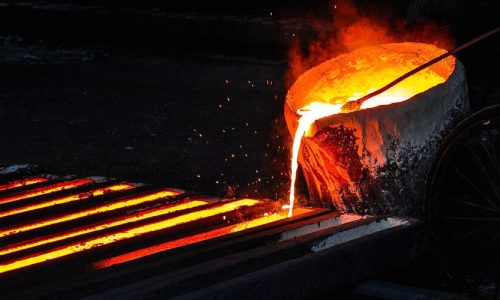
Formare
Formare è un'ampia categoria di processi che modellano il metallo senza rimuovere il materiale. Questi metodi utilizzano la forza per piegare, allungare o comprimere il metallo nella forma desiderata. Le tecniche di formatura standard includono la laminazione, la forgiatura e l'imbutitura.
La formatura è ideale per realizzare pezzi che richiedono elevata resistenza e durata. Viene utilizzata in settori come quello automobilistico per creare pannelli di carrozzeria, cornicie componenti strutturali. Il vantaggio principale della formatura è che mantiene l'integrità del materiale pur creando forme complesse.
Produzione di additivi
Produzione additiva o stampa 3DIl metodo di produzione di un pezzo è quello che prevede l'accumulo di strati di materiale per la creazione di un pezzo. Questo metodo è comunemente utilizzato per la prototipazione rapida e la produzione di bassi volumi. Può produrre pezzi altamente complessi e personalizzati che sarebbero difficili da creare con i metodi tradizionali.
Questa tecnologia è in crescita nei settori aerospaziale, automobilistico e dei dispositivi medici. La produzione additiva consente di realizzare strutture leggere e progetti dettagliati, riducendo al minimo gli sprechi di materiale.
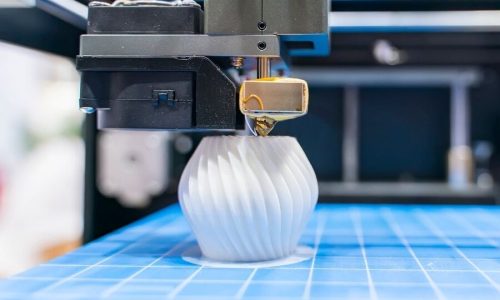
Quali metalli sono comunemente utilizzati nella lavorazione dei metalli?
Nella fabbricazione dei metalli, la scelta del metallo giusto è fondamentale per garantire che il prodotto finale funzioni bene e duri a lungo. Metalli diversi hanno proprietà diverse che li rendono più adatti a usi specifici. Vediamo alcuni dei metalli più comunemente utilizzati nell'industria della fabbricazione.
Acciaio
L'acciaio è uno dei metalli più comuni utilizzati nella fabbricazione. È forte e durevole e può essere miscelato con altri metalli per migliorarne le proprietà specifiche. I tipi più comuni sono quelli al carbonio, inossidabili e in lega. L'acciaio è spesso utilizzato per la produzione di parti strutturali, componenti automobilistici e macchinari perché è versatile e conveniente.
Alluminio
L'alluminio è leggero, resistente alla corrosione e facile da lavorare, il che lo rende una scelta popolare nell'industria aerospaziale, automobilistica ed elettronica. È comunemente usato per realizzare telai, pannelli e involucri. L'alluminio può anche essere anodizzato, il che lo rende più durevole e ne migliora l'aspetto.
Acciaio inox
L'acciaio inossidabile è noto per la sua resistenza alla corrosione e alle macchie, che lo rende ideale per gli ambienti difficili. È comunemente utilizzato nella lavorazione degli alimenti, nelle apparecchiature mediche e nell'architettura. La sua resistenza e la capacità di gestire temperature e pressioni estreme rendono l'acciaio inossidabile una scelta privilegiata per applicazioni pratiche e decorative.
Rame
Il rame è famoso per la sua eccellente capacità di condurre l'elettricità, che lo rende un materiale fondamentale per l'industria elettrica ed elettronica. È anche molto resistente alla corrosione, soprattutto in ambienti marini. Il rame è ampiamente utilizzato per cablaggi elettrici, impianti idraulici e componenti decorativi.
Ottone
L'ottone è una lega di rame e zinco. È noto per la sua resistenza alla corrosione e per il suo attraente colore giallo-oro. L'ottone è spesso utilizzato per la produzione di raccordi, valvole e strumenti musicali. È anche facile da lavorare, il che lo rende una buona scelta per la produzione di parti dettagliate utilizzate in applicazioni funzionali e decorative.
Bronzo
Il bronzo, una lega di rame e stagno, è apprezzato per la sua forza, resistenza all'usura e alla corrosione, soprattutto in ambienti marini. Viene spesso utilizzato per la produzione di cuscinetti, ingranaggi e hardware marino. La capacità del bronzo di resistere all'attrito e all'uso intenso lo rende una scelta popolare per le applicazioni ad alte prestazioni.
Titanio
Il titanio è leggero, resistente alla corrosione e ha un elevato rapporto forza-peso. Queste qualità lo rendono ideale per settori come quello aerospaziale e dei dispositivi medici. Il titanio è spesso utilizzato per componenti che devono essere forti ma leggeri. È anche noto per resistere alle alte temperature e agli ambienti difficili.
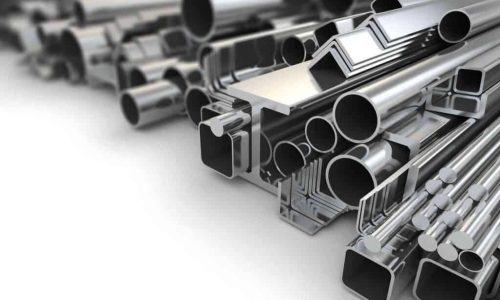
Quali sono i pro e i contro della lavorazione dei metalli?
La fabbricazione dei metalli è comunemente utilizzata nei settori automobilistico, edile e aerospaziale. Contribuisce a creare parti durevoli e personalizzate. Tuttavia, come ogni processo, ha i suoi vantaggi e le sue sfide. Vediamo più da vicino i pro e i contro della fabbricazione dei metalli.
I vantaggi della lavorazione del metallo
Personalizzazione
Uno dei maggiori vantaggi della fabbricazione dei metalli è la possibilità di realizzare prodotti personalizzati. Che si tratti di progettare un prototipo o di produrre parti in serie, la lavorazione dei metalli consente di ottenere progetti precisi e flessibilità.
Durata e resistenza
I componenti metallici realizzati attraverso la fabbricazione sono in genere robusti e duraturi. Metalli come l'acciaio, l'acciaio inox e il titanio sono noti per la loro resistenza e durata, che li rende perfetti per le applicazioni pesanti.
Ampia gamma di applicazioni
La fabbricazione dei metalli può creare molti tipi di prodotti, da semplici componenti a parti complesse. La varietà di materiali e metodi la rende utile in settori come l'edilizia, l'automotive, l'elettronica e l'aerospaziale.
Economicamente vantaggioso per la produzione di massa
La fabbricazione dei metalli può essere molto conveniente per la produzione su larga scala. Tecniche come lo stampaggio, la lavorazione e la saldatura consentono ai produttori di produrre molti pezzi in modo rapido e a un costo unitario inferiore.
Alta precisione e qualità
Grazie ai progressi tecnologici, metodi come la lavorazione CNC e il taglio laser offrono una precisione molto elevata. Queste tecniche sono in grado di produrre pezzi con tolleranze strette, assicurando che ogni articolo sia di alta qualità e consistenza.
Contro della lavorazione del metallo
Elevati costi iniziali di installazione
Sebbene la fabbricazione dei metalli sia conveniente per la produzione di massa, l'allestimento iniziale può essere costoso. Gli strumenti, le macchine e gli stampi necessari per lo stampaggio o la fusione richiedono un investimento significativo. Questo può rappresentare una sfida per le aziende più piccole o con budget limitati.
Flessibilità di progettazione limitata per alcuni processi
Alcuni metodi di fabbricazione dei metalli, come la fusione o lo stampaggio, non consentono di realizzare progetti molto complessi o intricati. Ad esempio, forme specifiche possono essere complicate o costose da creare con i metodi tradizionali.
Rifiuti materiali
La fabbricazione dei metalli può talvolta comportare scarti di materiale, soprattutto durante le fasi di taglio e lavorazione. Sebbene alcuni scarti siano inevitabili, se non gestiti correttamente possono aumentare i costi dei materiali e creare problemi ambientali.
Requisiti per la manodopera qualificata
La fabbricazione dei metalli richiede spesso lavoratori qualificati per far funzionare le macchine e creare progetti dettagliati. Questo può rendere l'assunzione e la formazione più lunghe e costose, e anche il mantenimento di personale qualificato può essere una sfida in alcune aree.
Applicazioni dei processi di fabbricazione dei metalli
I processi di fabbricazione dei metalli sono fondamentali per la creazione di prodotti per molti settori industriali. Vediamo come la fabbricazione dei metalli viene utilizzata in diversi settori.
Industria automobilistica
Nell'industria automobilistica, la lavorazione dei metalli crea parti come telai, pannelli della carrozzeria, sistemi di scarico e componenti del motore. Tecniche come lo stampaggio, la saldatura e la lavorazione meccanica sono comunemente utilizzate per rendere questi componenti precisi e durevoli.
Industria aerospaziale
L'industria aerospaziale ha bisogno di materiali forti, leggeri e resistenti a condizioni estreme. I processi di fabbricazione dei metalli, come la saldatura, la lavorazione e la fusione, sono ampiamente utilizzati per realizzare parti di aerei e veicoli spaziali.
Industria di costruzioni
Nell'edilizia, la fabbricazione dei metalli produce parti strutturali come travi, colonne e capriate che sostengono edifici e infrastrutture. L'acciaio e l'acciaio inossidabile sono comunemente utilizzati e fabbricati in forme e dimensioni diverse per soddisfare i requisiti ingegneristici.
Beni di consumo
La fabbricazione dei metalli è un processo importante per la produzione di beni di consumo, tra cui elettrodomestici, elettronica e mobili. Ad esempio, viene utilizzata per realizzare i telai di frigoriferi, lavatrici e televisori.
Energia e generazione di energia
La fabbricazione di metalli viene utilizzata per costruire attrezzature e infrastrutture per impieghi gravosi nei settori dell'energia e della generazione di energia. Tra queste figurano turbine, centrali elettriche, condutture e serbatoi di stoccaggio.
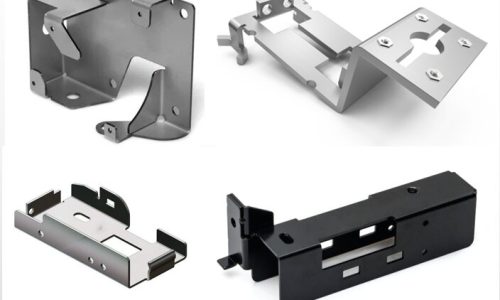
Come scegliere i fabbricanti di metalli?
La scelta del giusto produttore di metalli è essenziale per garantire la qualità e l'efficienza del vostro progetto. Sapere qual è il migliore per le vostre esigenze può essere una sfida con le tante opzioni disponibili. Ecco alcuni fattori chiave da considerare quando si sceglie un partner per la fabbricazione di metalli.
Esperienza e competenza
Una delle cose più importanti da considerare è l'esperienza del fabbricante. Un'azienda con anni di esperienza ha maggiori probabilità di gestire bene progetti complessi e di fornire risultati di alta qualità. Cercate fabbricanti esperti nel tipo specifico di metallo e nel processo di fabbricazione di cui avete bisogno, che si tratti di saldatura, taglio, piegatura o lavorazione.
Gamma di servizi
È essenziale scegliere un fabbricante che offra un'ampia gamma di servizi. In questo modo si ottiene una maggiore flessibilità e si ha la certezza di poter gestire ogni parte del progetto. Cercate fabbricanti in grado di eseguire sia la prototipazione che la produzione in serie. Inoltre, è bene che dispongano di capacità avanzate come la lavorazione CNC, il taglio laser o la stampa 3D, se il vostro progetto ne ha bisogno.
Qualità e precisione
La qualità del prodotto finito riflette le capacità del fabbricante. Assicuratevi che il fabbricante utilizzi materiali di alta qualità e attrezzature moderne per tagli, saldature e finiture precise. Chiedete informazioni sui loro processi di controllo della qualità e su come assicurano la coerenza del loro lavoro. Norme di certificazione come la ISO 9001 possono dimostrare che il fabbricante è impegnato nella qualità.
Attrezzature e tecnologia
Un fabbricante affidabile deve disporre di attrezzature e tecnologie moderne. Tra queste, macchine CNC, sistemi di taglio laser, strumenti di saldatura robotizzati e altre attrezzature avanzate che migliorano la precisione, la velocità e l'efficienza. Chiedete informazioni sulla tecnologia utilizzata per assicurarvi che soddisfi le esigenze del vostro progetto, soprattutto se si tratta di progetti dettagliati o di parti complesse.
Tempi e consegne
La puntualità delle consegne è importante per qualsiasi progetto. Informatevi sui tempi di consegna del fabbricante e sulla sua capacità di rispettare le scadenze. Un buon produttore fornirà tempistiche chiare e sarà aperto a eventuali ritardi.
Conclusione
La fabbricazione dei metalli comprende una serie di processi quali taglio, piegatura, saldatura, stampaggio, lavorazione, estrusione, fusione, formatura e fabbricazione additiva. Ogni processo svolge un ruolo cruciale nel plasmare il metallo per esigenze specifiche in diversi settori. La scelta del giusto processo di fabbricazione dipende dai materiali, dal design e dai requisiti del progetto.
Se siete alla ricerca di componenti metallici di alta qualità e di lunga durata per il vostro prossimo progetto, siamo qui per aiutarvi. Contattaci oggi stesso per iniziare e garantire che il vostro progetto soddisfi gli standard più elevati!
Ciao, sono Kevin Lee

Negli ultimi 10 anni mi sono immerso in varie forme di lavorazione della lamiera, condividendo qui le mie esperienze in diverse officine.
Contattate

Kevin Lee
Ho oltre dieci anni di esperienza professionale nella fabbricazione di lamiere, con specializzazione nel taglio laser, nella piegatura, nella saldatura e nelle tecniche di trattamento delle superfici. In qualità di direttore tecnico di Shengen, mi impegno a risolvere sfide produttive complesse e a promuovere innovazione e qualità in ogni progetto.

